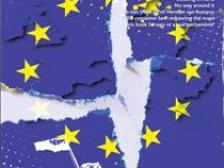Initiatives of Emil Stoyanov
EU REPORTER about the exhibition "Treasures from Bulgaria. The Gold of the Thracian Warriors." initiated by Emil Stoyanov

Article by Colin Stevens, published in the October issue of EU REPORTER
The foyer of the European Parliament in Brussels is the venue for an exhibition of gold and silver treasures from Bulgaria, paying homage the Bulgaria's ancestors from Thracia. Thracia - Тракия in Bulgarian, - was the name of a province of the Roman empire in Macedonia. It was established in AD 46, when the former Roman client state of Thrace was annexed by order of the Roman Emperor Claudius, who ruled from AD 41 to AD 54.
Ancient Greek artwork often depicts Thracians as redheads. Rhesus of Thrace, a mythological Thracian King, derived his name because of his red hair and is depicted on Greek pottery as having red hair and beard. Ancient Greek writers also described the Thracians as red haired. A fragment by the Greek poet Xenophanes describes the Thracians as blue-eyed and red-haired:
"Men make gods in their own image, those of the Ethiopians are black and snub-nosed, those of the Thracians have blue eyes and red hair."
The exhibition displays the artifacts of one Thracian warrior, followed by his richly decorated horse, with a number of gold and silver treasures. The exhibitions message to the descendants of ancient Europe consists of the most valuable ideas of the Thracians - belief in intellectual immortality, respecting Nature - the Great Goddess,- aspiration that the societal obligations be honoured in the three words - those of the gods, the humans and the Beyond.
The full-length reconstruction of the Thracian warrior is accomplished by exhibiting a slam and greaves from Pletena, Gotsedelchev region, a chain armour and golden breastplate from Chernozem, and a long sword (romphaea) - one of the most frightening Thracian weapons.
The horse protome with the placed appliqués for breast decoration, and the rein from the Letnitsa treasure, recall the Thracian cavalry, valued by all ancient military commanders. The images on the applications detail the royal ideology and the value trials that the Thracian aristocrats had to pass on their way to immortality.
The Panagyurishte and Borovo treasures, the "Apollo set", the three jugs from Rogozen treasure and the golden jug from the Mogilanska Mound illustrate the incredible importance of the rituals for the rulers and for Thracian society. The shapes decorating the containers and the inscriptions reveal the Thracians mythological notions and the ways of establishing diplomatic relationships between the ruling royal dynasties of the Odrysians, Tribalae and the Getae.
The exhibition includes also some of the objects discovered in the aristocratic burial near Zlatnitsa village, Elhovo region - a golden royal wreath, one of the silver rhyta, a bronze tympanon, and a silver greave decorated with mythological scenes, etc.
From the sumptuous gifts discovered in the burial of a ruler or a co-ruler in Topolchane village, Sliven region, known in particular for the golden burial mask, teh following objects have been included: two silver rhyta, a silver helmet, a ring with a portrait image of the aristocrat-warrior who has transcended to the Beyond, two golden phialae, a gold-plated silver goblet (cup), and horse trappings.
The finds from Topolchane village belonging to the History Museum - Sliven, leave the country for the first time. The golden mask itself is not travelling with the exhibition, but is represented by a gigantic photo next to another such photo of the other Thracian mask - the one from the "Valley of the Thracian Kings".
Initiated and partly financially supported by the Bulgarian Member of the European Parliament Emil Stoyanov, the exhibition with Thracian treasures from the National Museum of History, the Archaeological Museum in Plovdiv and the history museums of Lovech, Vratsa, Ruse and Sliven, is organized by the Ministry of Culture and the National History Museum. The scientific director of the exhibition is Prof. Dr. Sc. Valeria Fol and leader of the working group - Prof. Dr. Bojidar Dimitrov.
Emil Stoyanov said "For me it was extremely important to show exactly in the European Parliament that Bulgaria is one of the oldest European countries and that the country is the successor of an ancient and very important part of the European culture. It is important to remind this, because towards Bulgaria, which is one of the newest EU member states, often incomprehension and mistrust is shown.
The Thracian culture is an important part of the letter European civilization. The exceptional value of the Thracian art was clearly seen in the exhibition. I am also happy that the exhibition was visited by the President of the European Parliament, by the Chair of the Committee for Culture of the European Parliament Doris Pack and by the Bulgarian Prime Minister Boyko Borissov and the Foreign Minister Nikolay Mladenov, as well as the hundreds of guests. In this way the exhibition naturally evolved from a cultural event to an event with political importance.
Unfortunately Bulgaria is not that well-known in the countries of Western Europe. This is due to the fact that after the Second World War Bulgaria falls in the Russian sphere of influence. This puts the country in isolation from Europe lasting for 50 years, which cannot still be overcome entirely. I hope that gradually also through the work of the Bulgarian Members of the European Parliament this not-knowing to be overcome. Today it is important the West Europeans to know that Bulgaria is economically stable country with relatively high economic growth. Also it is a country with extremely old culture - Christian as well as pre-Christian and with population, which is now extremely attached to the European idea.
The exhibition achieved two things: Firstly, it awoke the interest in and the respect towards the Bulgarian history and Bulgaria as a whole. And secondly, it consolidated in one very pleasant way the Bulgarians, working in the European institutions and in Brussels."
More Initiatives of Emil Stoyanov:
» 20/06/2012 | 11:23 Initiatives of Emil Stoyanov - Emil Stoyanov meets students from Plovdiv
» 24/04/2012 | 15:13 Initiatives of Emil Stoyanov - The exhibition "The Legends from Bulgaria" in the European capital
» 28/10/2011 | 21:06 Initiatives of Emil Stoyanov - In Plovdiv the Pygmalion Foundation gave for the fifth time its annual award for contribution in the field of philology
» 11/10/2011 | 22:28 Initiatives of Emil Stoyanov - Opening of the exhibition "Treasures from Bulgaria. The Gold of the Thracian Warriors"
» 06/10/2011 | 17:20 Initiatives of Emil Stoyanov - Treasures from Bulgaria. The Gold of the Thracian Warriors



